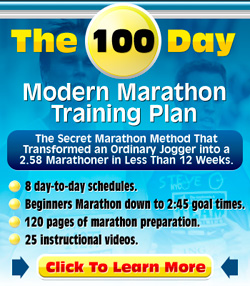 I know that is a very bold claim and, yes, the best type of workout does vary from individual to individual and running phase to running phase. Having said that, however, I’d like to share one of the absolute best running workouts that you can do in any phase of your running.
I know that is a very bold claim and, yes, the best type of workout does vary from individual to individual and running phase to running phase. Having said that, however, I’d like to share one of the absolute best running workouts that you can do in any phase of your running.
And it is highly effective.
Runners who use The 100 Day Marathon Plan are already familiar with this type of workout through the 45/15 workouts.
Simply stated, what you’re doing is running 15-25 intervals of short duration (30-60 seconds) with very short recoveries (10-20 seconds) at a gradually progressive pace. This means that each interval is faster than the previous one.
When you have hit the absolute hardest you can go on these, step off the treadmill/running track and take a 2 minute recovery. Then continue to do 5 more repeats at the same pace as the last one before the recovery.
The beauty of this type of workout is that you’re able to keep up a very high pace for a long time without going too anaerobic. Your heart rate keeps on increasing through all the sessions, and you’re able to maintain a high VO2 max all throughout.
You’ll be amazed how this type of workout can improve your running in any phase of your training.
I’ve used this type of workout for years, even when training for the Olympics back in 2000, and now science is starting to support it more and more as well.
The physiologist Véronique Billat, one of the world’s most-quoted exercise scientists, has a particular interest in VO2 max training. This article from Competitor pretty much sums up her 30/30 type work, which is very similar to what I talk about.
http://running.competitor.com/2014/01/training/workout-of-the-week-billats-30-30_33782
In addition to this the Danish scientist Jens Bangsbo has a shown very good results from a so called 10-20-30 workout where you do 3-4 blocks of 5 minutes running followed by 2 minutes of rest. Each block consists of 5 consecutive 1-minute intervals divided into 30, 20 and 10 seconds of running at a low, moderate and near maximal intensity, respectively.
http://www.eurekalert.org/pub_releases/2012-05/uoc-nrs053012.php
This is very similar to the 45/15 type work.
Three 45 /15 Type Workouts for You to Try
In addition to the 30/30 Billat workout and the Bangsbo workout above, here are some variations for you to try.
- 45 seconds running, 15 seconds recovery. Go faster and faster with each one. (On the treadmill, go 0.2 km faster for each interval.) Run 15-20 first and then step down. Continue with 5 more after a 2 minute recovery.
- Similar to #1, but with 1 minute running and 20 seconds recovery. The last 3-4, switch to 30 seconds running and 15 seconds recovery.
- 60-45-30-15 seconds running with 15 seconds recovery between each one. After each series (after each 15 seconds running, the last run in each series), step up the pace. Do 4-5 series of these. Use 15 second recoveries all through.
…and my correspondence with a 100 Day Marathon Plan member
To explain further the beauty of this type of workout, let me share with you my recent correspondence with one of the 100 Day Plan runners. He is a member of The 100 Day Plan VIP Section, an extra service which provides more personal support than the basic version of The 100 Day Plan.
*****
“Dear Marius,
I see that in your schedules there is very little (if any) training into effort zone 5. However, it is usually assumed that to improve your VO2 max, you have to train at a level which allows you to reach and spend some time at a high percentage of one’s VO2 max, and one usual way to do so is intervals at ~5K race pace (Daniel’s “I Pace”).
Canova, in his marathon book, suggests on his side that short steep hill sprints do that. French physiologist Véronique Billat has just released a book with a new (supposedly revolutionary) approach to VO2 max training, but it looks quite technical. (I just had a look through Amazon.)
I understand that during the last ~100 days leading to the marathon we have better things to do than focusing on VO2 max development. However, as I have quite some time before starting my marathon training plan (~6 month, I’ll aim at San Sebastian marathon which takes place the end of November), I’m wondering whether I could, after my (ongoing) base training period and before starting the marathon schedule, dedicate some time to a VO2 max training period.
What do you think? And what is, according to you, the best training to improve one’s VO2 max?
Best wishes from Paris,
Benoît”
“Benoît,
The simple reason for the lack of Effort 5 training is that the upside of it is very limited while the downside is huge. Running at that intensity while marathon training increases the risk of both injuries and muscular overtraining, due to the combination of long monotonous marathon training plus high intensity work.
I’m well aware of the work of Véronique Billat. She was a big fan of intense 4 minute intervals before. (She was again inspired, from what I’ve seen, by Dr. David Martin who worked with Seb/Peter Coe, and Billat again seems to have inspired Helgerud and Hoff, two Norwegians scientists who do similar research)
Her new focus seems to be more short intervals with short recoveries– mostly 30 seconds hard running, 30 seconds recovery. I’ve been a fan and seen the effect of this type of work for 15 years. You can see it in The 100 Day Plan with my 45/15 intervals and the other short intervals with short recoveries sessions. This type of work is well known among world class runners and isn’t new. AND, while it is a great way of boosting the shape (the icing on the cake), it is by no means something you can do alone. You need the well-rounded approach to it, like I recommend.
The best way to improve VO2 Max?
Simple. Lose weight. 😉
The second best way is to train smart with anaerobic threshold work and some 45/15 type work. It will come naturally with time with little injury risk.
All the best,
Marius”
“Hi Marius,
Thank you very much for your kind and swift answer. You’re right. The best way to boost my (relative) VO2 max is certainly the NWLC. 😉 So maybe, with the extra time I’ve got, I’ll consider extending the plan as you suggest and explain than doing something quite different than before.
As for the short interval type 45/15, 20/20, etc., I’ve been through the VIP section but I still have some doubt… at which speed am I supposed to run the fast parts?
If the intervals are, for instance, 30x(20″ zone 4/20″ rest), am I supposed to run the 20″ at a speed at which my heart would stabilize into zone 4 if run continuously (without the 20″ break) for a more extended period of time, or am I supposed to run the 20″ at a speed at which the heart will stabilize within the zone 4 before the end of the fast 20″ fraction?
For me it makes a huge difference, as for a very short fraction of 20″ I would like to run very fast (much faster than the pace indicated for zone 4) to get my heart in the zone before the end of the 20” fast part, at least for the first few fractions. Or, maybe, as a compromise, I may choose to run the first ~5-6 fractions with the heart below zone 4, gradually increasing HR at the end of each subsequent fraction, and get the heart stabilized into zone 4 for the last ~25 fractions (which would still mean a great deal of effort within zone 4 on the whole).
Then, when for another session, 25x(45 /15), you indicate “effort 3 at the beginning, effort 4 toward the end”, I guess that you mean that the first ~15-20 fractions of 45/15 will be run with the heart within effort 3 zone (maybe first ~3-4 below zone 3), and gradually increasing the HR attained at the end of each subsequent fraction in order to reach bottom of zone 4 for the last ~5-6 fractions ?
Thanks a lot,
Benoît”
“Hi Benoît,
I’ve set the “ceiling” of the progressive 45/15s at Effort 4. However, if you are injury free, you can pretty much go as hard as you like at the end of those, as long as you have a progression going all through them (faster and faster for each one). The very short recovery makes the session’s intensity self limiting, and you can allow yourself to be really, really tired–especially during the last 5-6 of these.
The point is, these are about the only sessions to go “free” on in terms of hardness/speed, as long as there is progression in them.
All the best,
Marius”
“Ok! The 45/15 sessions are really some type of Billat’s style VO2 max training!
Thanks a lot,
Benoît”
*****
Conclusion :
As you can see, if used wisely in a well rounded training plan (with plenty of anaerobic threshold work like in the 100 day marathon plan) , the 45/15 type sessions are a superb way of improving your running performance. It is well worth a try.
I hope you enjoyed this article…
If you did, please share and comment. I’d love to discuss the article with you in the comments section as well.
Want more stuff like this?
We’re on a mission to spread meaningful running and marathon content.Sign up for updates and 15 free running workouts, and see for yourself!
–> Click here to subscribe to my mailing list<–




Leave a Reply